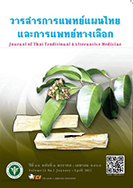A Study on Indigenous Knowledge on Paralysis Therapy: A Case of Mae Chanli Plian-ek
Main Article Content
Abstract
This qualitative research was conducted with the objective of exploring indigenous massage knowledge
and experience of a Thai folk healer named Mae Chanli Plian-ek on paresis/paralysis therapy
using an in-depth interview. Dataûs content analysis was performed. The results revealed that the healer
used a local massage technique called çkhit-sené and herbal drugs for treating paralysis patients. The
following were steps used in the massage therapy; (1) assess the patientûs condition and make diagnosis;
(2) stimulate the nerves by herbal grilling technique; (3) put the patient for herbal steam bath; (4) give
a massage using the çkhit-sené technique, stimulating tendons and blood vessels to boost blood flow; (5)
check the reflex response of the feet; (6) stimulate the tendons and blood vessels; (7) have the patient
practise waist exercise to stimulate the central nervous system; and, (8) train the patient to sit up, stand
and walk. Do steps 2-8 twice daily, one in the morning and the other in the afternoon for 15 days to 3
months depending on the patientûs conditions. In her 52 years of therapeutic massage experience, she
has treated more than 600 paralysis patients, approximately one per month, most of whom could live
a normal life after treatment. In conclusion, the paralysis massage treatment given by Mae Chanli
Plian-ek, a folk healer/masseur, consists of eight steps and is interesting; and it may be used for treating
paresis/paralysis. A further study using a clinical research to verify its effectiveness is suggested.
Article Details
References
2. Thai Stroke Society. Stroke situation [Internet]. 2015 [cited 2015 Nov 5]. Available from: https://thaistrokesociety.org//purpose/
3. Bureau of Policy and Strategy, Office of Permanent Secretary. Thailand healthy lifestyle strategic plan, B.E. 2554-2563 (2011-2020). Bangkok: National Buddhism
Press; 2010. 47 p. (in Thai)
4. Ratree Pranakhon (interviewer). Document interviews çIndiginous knowledge on paralysis therapy: A case of Mae Chanli Plianaeké: 17 August 2013. (Mimeographed).
(in Thai)
5. Chokevivat V, Sobhansiri S, Suksut P. Indigenous Wisdom Records: Janlee Plianaek, Outstanding Thai Traditional Medical Doctor, 2013, with volunteer spirit
of Ban Non Hom, Non Hom subdistric, Mueang district,Sakon Nakhon province. Journal of Thai Traditional & Alternative Medicine. 2016;14(2):204-11.
6. The Heart Association of Thailand Under The Royal Patronage of H.M. The King. Guideline to anticoagulant therapy [Internet]. n.d. [2016 May 25]. Available from:
http://www.thaiheart.org/images/column_ 1292154183/ warfarin_Guideline(1).pdf (in Thai)
7. Smutrautsadong V, Rungruengduayboon B, Koonkumchoo P. The design and development of device for stroke. 1st Conference on Graduate Student Network
of Thailand; 2012 December 1-18; Thammasat University. Sci-Tech 018. (in Thai)
8. Dedkhard S. Effects of rehabilitation program using complementary therapy in stroke patients. J Prapokklao Hosp Clin Med Educat Center. 2015;32(2):135-46. (in
Thai)


